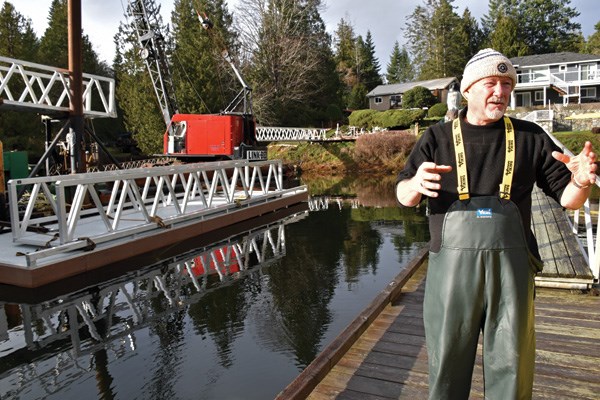“Euphoric” is the word Pender Harbour resident Brad Clarke used to describe his feeling when, documents in hand, he’d realized the delay was over.
“[I] just couldn’t believe it. After a seven-year wait, it felt surreal.”
Clarke received permission from the Ministry of Natural Resources (FLNRORD) in early December to build a private dock at their waterfront property, making his the first application green lit by the province under the Pender Harbour Dock Management Plan (DMP).
A small team installed the structure over three days, starting Jan. 23.
To a casual observer, the long walkway and rectangular float jutting out from the sloping lawn fits, unremarkably, with the surrounding docks characteristic of Pender Harbour. To Clarke, “it’s a dream.”
The approval symbolically cracks open the moratorium on dock construction that has effectively lasted more than 15 years.
Gerrans Bay is part of the Zone 3 boundary under the DMP, the least restrictive classification. New docks and boathouses are barred from Zone 1 and some new constructions, mainly commercial docks, may be allowed in Zone 2.
Despite being a “very tedious, long process with many, many steps,” Clarke wants his experience to give others faith. “Certainly my hope is that if people are providing the science and the correct reports … the provincial government and the Sechelt Band will be open to looking at opportunities for other people, regardless of zone.”
Faith was a key ingredient in Clarke’s process. He and his wife purchased their waterfront property in 2011 knowing the moratorium was in place, “probably with the misunderstanding that the province and Sechelt Indian Band were reaching an agreement in the near future.”
When the province opened up dock applications for a short period during 2013, “we seized the opportunity,” said Clarke. Progress halted after the 2013 window closed, but Clarke remained “in constant touch” with the province and also reached out to shíshálh Nation. “They were very receptive and very straightforward, and it was actually a good dialogue,” he said.
Once the DMP was released in 2018, the application process recommenced and it was reviewed by the DMP working group, comprising FLNRORD staff and members of the shíshálh Nation.
Consultations with the Department of Fisheries and Oceans were needed, and more reports, including from a biologist and archeologist. The group also requested a letter from a structural engineer to justify two variances.
Gerrans Bay is considered a “dry bay” – losing most of its water at low tide. Under the plan, docks must not sit on the bottom of a seabed and a minimum height of 1.5 metres from the bottom must be maintained at all times.
To overcome that hurdle, the float is outfitted with special aluminum “landing pads” that attach to legs designed to keep it off the seabed, even at lowest tide. “It’s like the lunar module on the Apollo mission,” said Clarke. FRP decking allows light to pour through the dock and into the water – another environmental requirement of the plan.
Clarke requested a variance for the float to rest at one metre, rather than the 1.5 metres stipulated under the plan. He also asked for a float width of approximately three metres, needed for the design to work. Floats are supposed be a maximum of 1.5 metres wide.
After the additional documents were submitted, the application went before the shíshálh Nation chief and council for review and signoff.
Bill Charlton of the Pender Harbour and Area Residents Association (PHARA) has been seeking amendments to the DMP, some of which apply to situations like Clarke’s. “We are very pleased to see that in practice this is already being done for a new installation. Grandfathering is also an important consideration, as the financial outlay for a new structure, such as Brad’s, would be beyond the ability of many homeowners,” Charlton told Coast Reporter in an email.
Clarke said “the costs did add up,” but for him, the effort was worth it. “My hope is that it’s going to help others in Pender Harbour.”
According to FLNRORD, 20 other applications for new docks have been submitted in the Pender Harbour area, with approvals pending. Of the approximately 190 “complete applications” received for the replacement of existing dock tenures, 40 have been issued across all zones. No dock removal orders have been issued. “For unauthorized docks that require removal, owners will be contacted to discuss the available information and the process,” according to a FLNRORD spokesperson.
FLNRORD also advised all applicants “to be thorough with their applications to avoid any unnecessary delays in decisions.”



